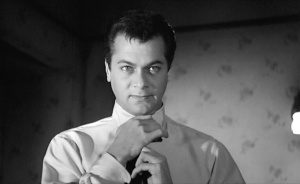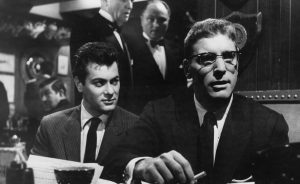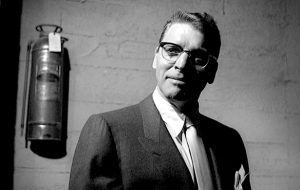While the situations and themes within noir films can vary dramatically—for instance Kiss Me Deadly’s brooding science fiction compared to Sunset Boulevard’s dark social satire— the one integral plot point that remains consistent for all of film noir is the investigation of a crime. Usually, the crime becomes immediately apparent in the first few minutes of each film, whether it’s already happened, as in Double Indemnity, or it’s occurring live on screen, as in The Maltese Falcon. Keeping this idea in mind, Alexander Mackendrick’s 1957 Sweet Smell of Success can hardly be considered a noir film at first glance. While its characters are unscrupulous, greedy, and conniving, they operate entirely within the limits of the law. In fact, it isn’t until the last twenty-five minutes of the film that an actual crime is introduced. It is in this way, by refusing to include a formal crime until the story’s end, that Sweet Smell of Success seeks to re-define the meaning of crime and proves itself as a unique and worthy addition to the noir genre.
Like many noir films, the moive was adapted from a prior work: a novella titled Tell Me About It Tomorrow, written by Ernest Lehman. Lehman adapted his work into the screenplay along with Clifford Odetts and Mackendrick. The story features smart, fast-paced dialogue and follows one press agent’s tireless and immoral efforts to keep himself in the good graces of an extremely powerful newspaper columnist. Tony Curtis stars as Sidney Falco, the scheming press agent, and Burt Lancaster is J.J. Hunsecker, the legendary columnist. Sidney Falco was an uncharacteristically villainous role for Tony Curtis, who normally played pretty boy type characters. If audiences have any confusion at the start of the movie over the nature of Curtis’s character, they are immediately put to rest by Falco himself.
“You think I’m a hero,” Falco says, all but winking at the audience six minutes into the film. “Well, I’m no hero. I’m nice to people where it pays me to be nice.”

Sidney Falco is not who you think he is.
Falco is true to his word: he snaps at his secretary, ignores his clients’ phone calls, pressures his lover to prostitute herself to an older man, and prints a false smear on a man’s reputation, all for his own self-gain. If Falco is bad, J. J. Hunsecker is even worse. The columnist makes a living off of other people’s misfortune, printing as much gossip and sensationalism as he can get his hands on. His power to print anything makes him dangerous; he will print requests, but only if given favors in return. It is this cycle of information and favors that serve as currency for Hunsecker and his underlings, including Falco.
Perhaps the ugliest plot that Hunsecker directs is his plan to break apart the relationship between his sister and her boyfriend. While the film avoids the typical noir tropes, Susan Hunsecker, played by Susan Harrison, serves as an inadvertent femme fatale for her brother. Susan is timid, quiet, and totally atypical for the archetype, yet she holds tremendous power over J.J., and, indirectly, Falco, even if she seems unaware of it. Ultimately, without giving too much away, Susan has her revenge on both men, cementing her role as the femme fatale.
Mackendrick’s directorial style notably avoids most of the stylized cinematography typical of noir. Camera angles are relatively simple, consisting almost solely on medium to medium-close up shots with the occasional long shot thrown in. A normal lens appears to be used and no characters are stylistically distorted in the frame. The film also has unusually high key lighting for noir; it saves the high contrast lighting for important dramatic scenes. One such scene is where Hunsecker is first physically introduced. While Falco and the background are well lit with high key light, Hunsecker’s face is covered with contrasted shadows, giving him a mysterious appearance that only serves to further boost his legendary reputation.

Sidney Falco has less contrast in his face than J.J. Hunsecker because he’s not as powerful.

J.J. Hunsecker is lit with extreme contrast for his dramatic moments.
One classic noir component that is also included in the film is the way that the environment, New York City, is a character in itself. From the opening titles, as Hunsecker’s newspaper truck rolls out onto the streets to Elmer Bernestein’s raucous, jazzy score, the extended shots of the city’s flashing signs, shouting people, and general hubbub portray a frantic, wild setting that is caught up in its own web of greed.
“I love this dirty town,” Hunsecker remarks, and, judging from the size of Hunsecker’s name on the delivery truck (which is where the character is truly first introduced), the town loves him back.
The opening titles from Sweet Smell of Success.
By making New York City a character in its own right, the writers of Sweet Smell are making a statement beyond commenting on the greed of a few solitary characters. Rather, they make it clear that our society as a whole feeds this cycle of maliciousness that ruins lives and livelihoods while operating entirely within the law.
Eventually, however, Hunsecker coerces Falco into breaking the law. While Falco struggles with the idea at first, suggesting that he might actually have moral principles after all, his greed soon gets the better of him. Hunsecker, meanwhile, convinces himself that the real crime would be to not commit it because this would allow an individual bucking the system of deceit to go free. Hunsecker is so wrapped in his own web that he has created his own backwards system of morality and lost all sense of what a crime truly is.
Hunsecker convinces Falco to break the law.
If the writers had intended for the film to simply explore the danger of committing small atrocities because it makes it easier to finally commit a real crime, the crime that Falco ultimately commits would have appeared much earlier in the movie, not the last 25 minutes. By waiting to add this component until the very end, the writers bring attention to the idea that crime is not limited to the legality of an action. Crime does not have to be murder, as most noir films focus on. Rather, Sweet Smell’s crime consists of the daily acts of cruelty that has become a way of life for the principle characters. The fact that the crime is legal in some ways only makes it more loathsome.
It is because of this idea that Mackendrick’s film provides a fresh perspective and expansion on the noir genre. Audiences of 1957 may have expected a film with a charismatic hero, or at least a villain that is easy to condemn, with clear standards of right and wrong. What they received instead was a charismatic anti-hero that never redeems himself and never stops to question the hazy shade of gray that he operates in. It is instead left for the viewer to consider the full impact of his–and ultimately society’s–actions.

Recent Comments